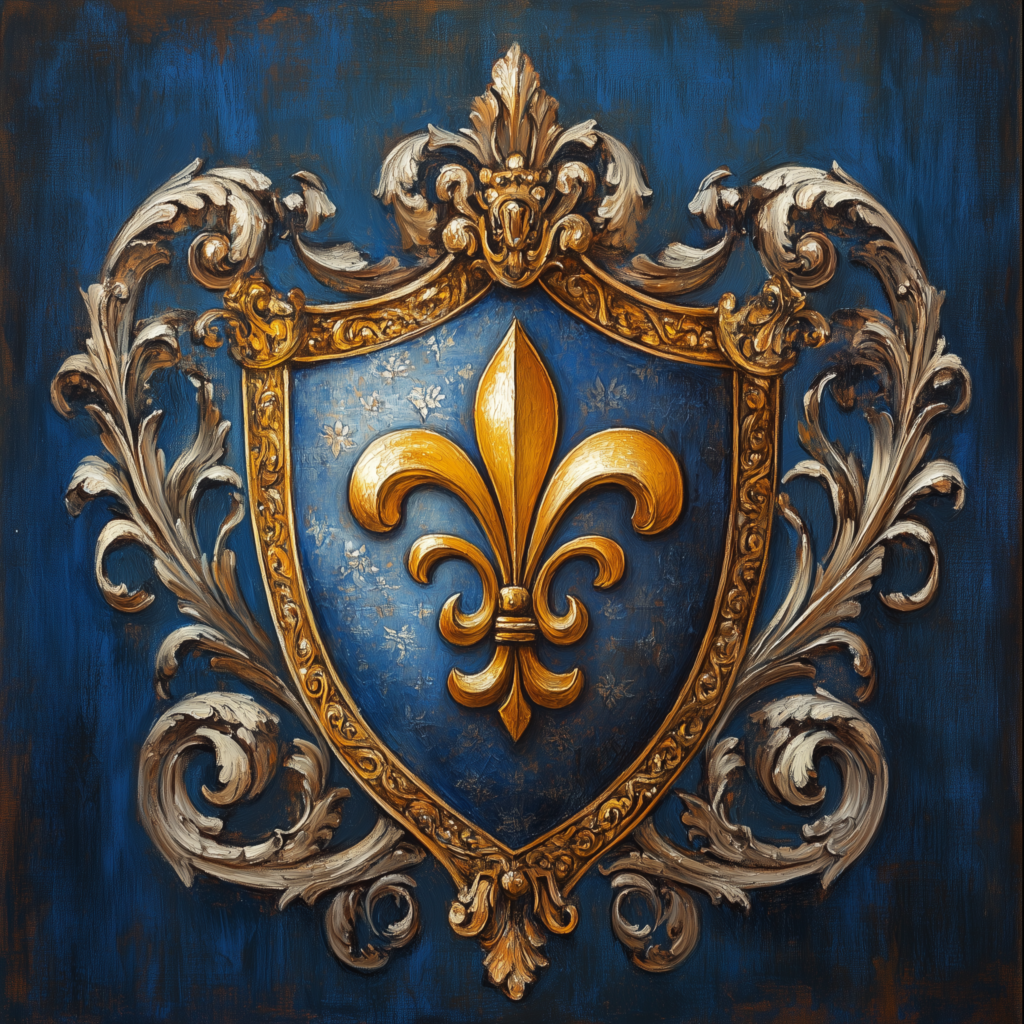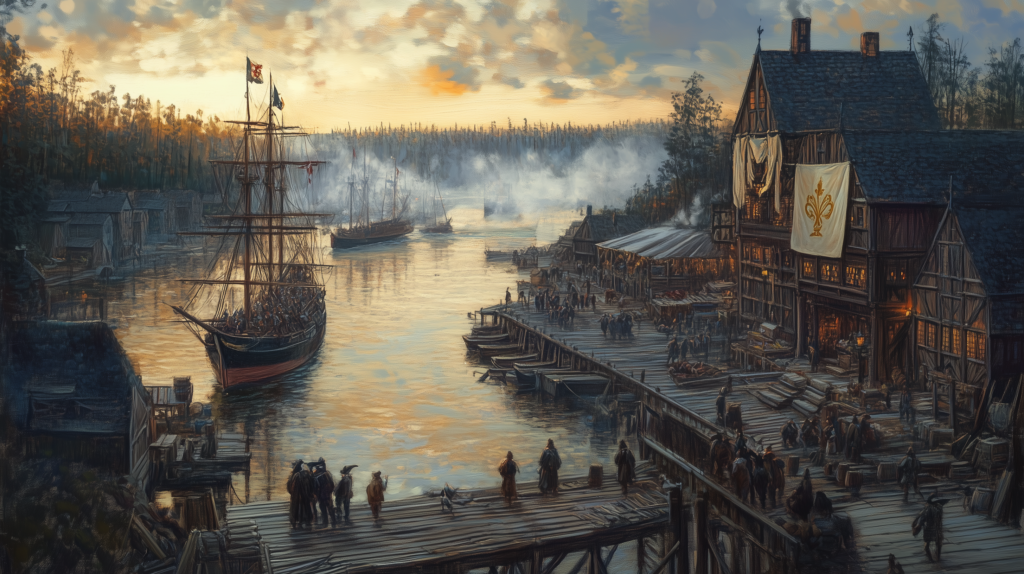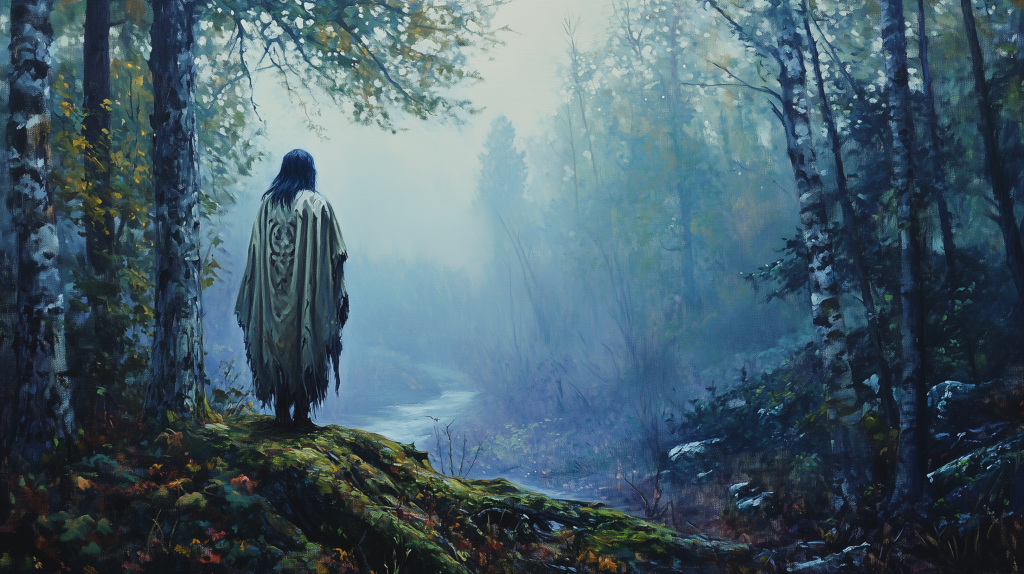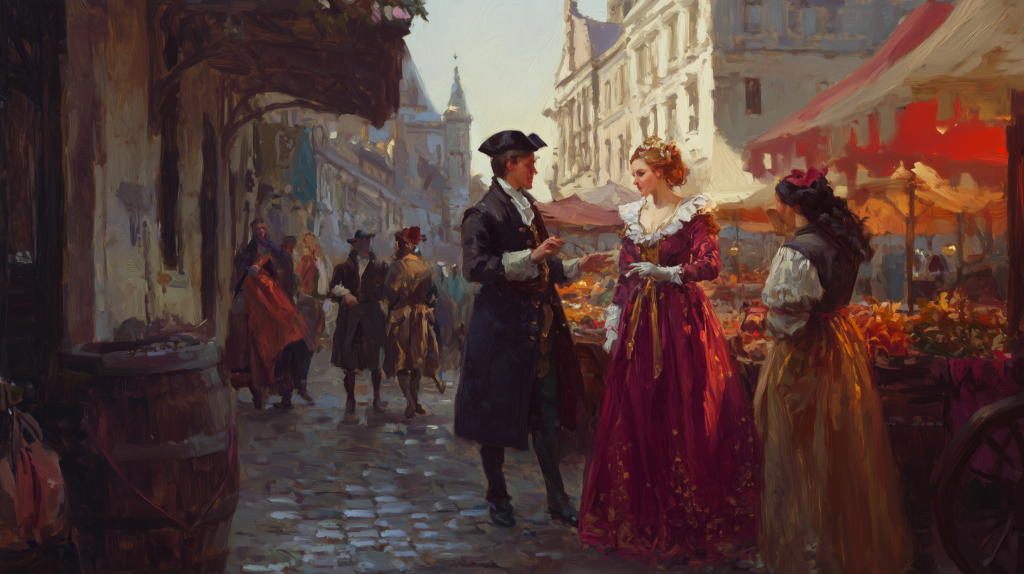Viceroyalty of New France
“Discover the wild secrets of New France—a realm where ruthless kings, untamed wilderness, and spine-chilling legends collide!”

- Location:
New France spans a vast region of the northern continent, encompassing dense forests, rolling plains, icy tundras, and winding river networks. Major waterways like the St. Laurent River serve as vital trade routes, while the towering Laurentian Mountains act as a natural barrier between inland settlements and the rugged northern frontier. Its territories extend from the temperate coastal regions of the east to the frigid reaches of the Great Northern Bay. - Other Names:
- The Fleur-de-Lys Dominion
- The Northern Crown
- The Lands of the White Stag (used by native cultures)
- Vinelande (an archaic name used in seafaring myths)
- Description:
A land of striking contrasts, New France is dominated by vast untamed wilderness interspersed with fortified settlements, trading outposts, and grand colonial cities. Its climate ranges from humid summers and bitterly cold winters in the south to permanent snowfields in the far north. The land is abundant with natural beauty, from sprawling pine forests and roaring waterfalls to golden fields of wild grain and eerie, mist-laden bogs. - Real-World Inspirations:
Inspired by a mix of historical 17th–18th century French colonial Canada and an alternate world where native traditions and Old World mysticism remain dominant. The aesthetics draw from early modern European settlement styles blended with indigenous influences, creating a world where fur trappers, musketeers, and shamans walk side by side. - Heraldry and Symbols:
- Coat of Arms: A golden Fleur-de-Lys on a deep blue shield, surrounded by silver pine branches and a crowned white stag, symbolizing purity, endurance, and royal dominion.
- Flag: A blue field adorned with three golden Fleur-de-Lys, representing faith, sovereignty, and unity under the ruling crown.
- Common Symbols: The White Stag (a sacred omen of prosperity), the Crescent Moon (protection from dark forces), and the Silver Pine (symbol of resilience and longevity).
- National Motto and Ideals:
“Strength Through Unity, Wisdom Through Tradition.”
This reflects the balance between maintaining order under the crown and honoring the diverse customs of the land’s inhabitants. - Moral and Philosophical Outlook:
New France values hierarchy, duty, and the natural balance of the world. Nobility and honor are esteemed, but pragmatism and survivalism shape the attitudes of those who live in the frontier. The people believe in the wisdom of elders, the sacredness of the land, and the importance of cooperation between different peoples to endure the region’s many dangers. - Spiritual and Religious Landscape:
The spiritual traditions of New France are deeply tied to the land, guided by nature spirits, ancestor worship, and celestial cycles. Powerful druidic orders coexist with state-sanctioned mystic institutions, preserving knowledge of ancient rites. Temples dedicated to elemental forces, river gods, and warrior-guardians stand alongside shrines where travelers leave offerings for safe passage. - Government:
New France is a Viceroyalty, ruled by a Viceroy appointed by the Crown of the Old World. Below the Viceroy, regional governors manage different territories, while noble landowners, military officers, and native leaders hold sway over local affairs. A powerful merchant council oversees trade policies, ensuring the colony remains profitable for its patrons across the sea. - Military:
- The Royal Musketeers of New France: Elite warriors tasked with defending settlements and enforcing the Viceroy’s laws.
- The Silver Wolves: A specialized ranger force trained in wilderness survival, tracking, and guerrilla warfare.
- The Gilded Dragoons: A heavy cavalry unit that patrols major trade routes and defends outposts from incursions.
- The Grand Armada: A powerful fleet that protects maritime trade and defends the coastal cities.
- Economy:
The economy thrives on fur trading, timber, and mineral wealth. Beaver pelts are the most valuable commodity, fueling a vast trade network. Agriculture is limited to settlements in the warmer south, while hunting, fishing, and river trade sustain frontier communities. Skilled artisans craft fine muskets, enchanted relics, and luxurious textiles imported from the Old World, while alchemists experiment with new potions drawn from the exotic flora of the region. - Technology Level:
Comparable to the early modern era, with muskets, flintlock pistols, alchemy, and early steam-powered experiments. Magic is integrated into daily life, with runesmiths, astrologers, and herbalists filling roles similar to scientists and engineers. The fusion of Old World metallurgy and native craftsmanship results in uniquely durable weapons and enchanted hunting tools.
- Present-Day Threats and Challenges:
New France faces numerous dangers, both from within and beyond its borders:- Rival Powers: Competing colonial empires seek to seize New France’s rich resources, leading to skirmishes along disputed frontiers.
- Native Uprisings: Some indigenous factions have allied with the colonial rulers, while others resist encroachment, leading to ongoing conflicts.
- Wilderness Dangers: The vast, untamed forests harbor rogue mercenaries, outlaws, and monstrous creatures that threaten remote settlements.
- Mystical Corruption: Strange forces seep from ancient ruins deep in the wilderness, twisting nature and summoning eldritch horrors.
- Political Intrigue: Factions within the colonial administration vie for power, some loyal to the ruling crown, others seeking independence.
- Population and Society Composition:
The people of New France are a mix of settlers, natives, and foreign traders, organized into distinct social classes:- Aristocracy: High-ranking nobles, including the Viceroy and governors, control vast estates and wield significant power.
- Merchants & Guildsmen: Wealthy traders, craftsmen, and ship captains who maintain the colony’s economy.
- Militants & Musketeers: The colony’s standing army, including the Royal Musketeers, dragoons, and mercenary forces.
- Frontiersmen & Hunters: Independent fur traders, trappers, and rangers who live on the fringes of civilization.
- Indigenous Tribes & Allies: Some native groups have allied with the colony, serving as scouts, warriors, and diplomats.
- Mystics & Shamans: Spiritual leaders and magic practitioners who blend Old World sorcery with native rituals.
- The Structure of Authority:
Power is structured in a rigid hierarchy, ensuring order in the colony:- The Viceroy: The ruler of New France, appointed by the Old World Crown.
- Provincial Governors: Each region is overseen by a governor, enforcing the Viceroy’s decrees.
- The Colonial Council: A governing body of noble lords, military leaders, and influential merchants.
- Local Magistrates: Officials in charge of settlements, overseeing trade, law, and security.
- Native Envoys: Ambassadors from allied tribes who act as intermediaries between colonial forces and native factions.
- The Decision-Makers:
- Viceroy Antoine de Rochefort – The Crown’s representative, ruling with an iron will.
- General Étienne Valmont – Commander of the colonial army, a seasoned war hero.
- Governor Marguerite Duval – The shrewd leader of the northern provinces, rumored to practice mysticism.
- Merchant Lord Pierre Lavalle – The wealthiest trader in New France, controlling vast shipping routes.
- High Shaman Tahu’khan – A native elder respected for his wisdom, seeking peace between cultures.
- Monarch or Ruling Power:
New France is ruled by King Louis the Everwise, a distant sovereign whose ambitions shape the colony’s future. While his influence is felt across the ocean, the Viceroy holds the real power in daily governance. - Famous Figures and Influencers:
- Captain Alaric Montreaux – A legendary explorer who vanished in the northern tundras.
- Mother Geneviève – A healer and prophetess, said to have visions of impending calamities.
- The Black Fox – A masked rebel leader fighting against colonial rule.
- Noteworthy Locations and Landmarks:
- Port-Saint-Laurent – The capital and largest port city, bustling with trade and military presence.
- The Silver Citadel – A grand fortress safeguarding the colony’s heartland.
- The Veilwood – A haunted forest where whispers are heard among the trees.
- The Frozen Wastes – A perilous land to the north, home to ancient ruins and forgotten lore.
- Power, Influence, and Reach:
- New France controls vast trade networks, supplying furs, timber, and precious minerals to the Old World.
- Its naval fleet dominates the western seas, ensuring colonial dominance.
- Expansion efforts continue inland, though tensions with native factions slow progress.
- Alliances, Foes, and Diplomacy:
- Allied Tribes: Some indigenous nations have allied with the colony in exchange for weapons and trade goods.
- Rival Colonies: Other European powers seek to undermine or conquer New France.
- Secret Societies: Underground groups work toward independence, resistance, or occult ambitions.
- Inhabitants/Creatures:
- Wendigos – Cursed beings that stalk the tundra, preying on the unwary.
- River Serpents – Enormous creatures said to dwell in the colony’s deepest waters.
- Stone Guardians – Ancient, enchanted statues found in lost ruins, rumored to protect forgotten secrets.
- Conditions/Temperature/Terrain:
- Winters are harsh, lasting many months with frequent blizzards.
- Summers are mild but brief, with endless daylight in the far north.
- The land consists of vast forests, frozen tundras, rugged mountains, and fertile river valleys.
- Weather Hazards:
- Snowstorms frequently block trade routes and isolate settlements.
- Rogue Waves threaten ships navigating the stormy coasts.
- Aurora Tempests (supernatural northern lights) disrupt magic and navigation.
- Notable Features:
- The Everfrost Caverns – Said to hold veins of magical ice that never melts.
- The Whispering Stones – A circle of monoliths inscribed with ancient glyphs.
- The Lunar Falls – A waterfall that glows under moonlight, believed to be sacred.
- Common Languages:
- Francais Imperial – The official language of governance and trade.
- Frontier Creole – A mix of native dialects and Old World speech, used in informal dealings.
- Sacred Tongues – Certain mystical orders and indigenous shamans use languages believed to carry magical power.
- Cultural Events or Festivals
- Seasonal Celebrations:
- Harvest Festival: A grand celebration marking the end of the agricultural season, featuring feasts, music, and public ceremonies honoring the land’s bounty.
- Festival of the White Stag: A mystical event where communities honor the sacred White Stag as an omen of prosperity, blending indigenous rituals with colonial pageantry.
- Celestial Observance: Nightly gatherings during the solstice to study the stars, share lore, and perform rituals meant to harness the celestial energies believed to guide fate.
- Local Laws or Customs
- Legal Traditions:
- The Code of Natural Balance: Laws emphasizing the respect and preservation of the natural world, reflecting both indigenous customs and colonial mandates.
- Customs of Honor: A strict code of conduct among the nobility and military, where duels, public debates, and formal apologies are used to resolve disputes.
- Trade Regulations: A well-defined system governing the fur trade, where merchants must adhere to guidelines ensuring fair exchange and mutual respect between settlers and indigenous traders.
- Social Customs:
- Rite of Passage Ceremonies: Both colonial and indigenous communities observe formal ceremonies marking the transition from youth to adulthood, often involving tests of skill, endurance, and spiritual connection.
- Public Festivals and Rituals: Regular public celebrations and rituals reinforce community bonds and the shared cultural heritage of New France, from religious observances to seasonal fairs.

Sample Wilderness Encounters
Sample Civilized Encounters
Viceroyalty of New France, Wilderness Encounters

Low-Level (1-5) Wilderness Encounters
(New adventurers contend with strange creatures, eerie folklore, and harsh wilderness survival.)
| d12 | Encounter |
|---|---|
| 1 | A pack of wolves (3d4) trails the party, keeping their distance… until night falls. Their howls seem strangely coordinated. |
| 2 | The party stumbles upon a Giant Beaver’s dam, which has diverted a river and flooded a nearby settlement. The massive creature is highly territorial but might be reasoned with. |
| 3 | Pukwudgies (1d6) harass the party, leading them into deadfalls and traps while laughing in eerie, childlike voices. |
| 4 | A Black Bear emerges from the woods, its eyes milky white. A local elder insists it is a spirit-touched animal and should not be harmed. |
| 5 | The party finds an abandoned hunting cabin, its walls clawed apart. Strange tracks lead into the woods. |
| 6 | A lost French trapper pleads for help—something in the forest mimicked his voice and lured away his partner. |
| 7 | The party stumbles upon a sacred Indigenous site protected by ancestral spirits—disturbing it may have consequences. |
| 8 | A lone woman in a fur cloak watches the party from a riverbank. She warns them of an impending flood—she is a Beaver Woman, testing their respect for nature. |
| 9 | A herd of bison (1d10) stampedes through the valley, threatening to trample the party unless they react quickly. |
| 10 | The wind whispers each character’s name. A Baykok (undead hunter spirit) is watching, waiting for a weakness. |
| 11 | A child from a frontier village is missing. Locals suspect Bonhomme Sept-Heures, a boogeyman who steals misbehaving children. |
| 12 | A thick unnatural fog rolls in. Shapes move inside, just beyond the party’s sight. They are not alone. |
Mid-Level (6-10) Wilderness Encounters
(Stronger adventurers face legendary beasts, vengeful spirits, and unnatural forces.)
| d12 | Encounter |
|---|---|
| 1 | A Wampus Cat lurks in the forest canopy, its hypnotic gaze attempting to lure someone away from the group. |
| 2 | The ruins of a French fort stand silent. Ghostly soldiers reenact their final battle each night, forever caught in their tragic fate. |
| 3 | A massive Giant Beaver is constructing a dam so large it’s altering the entire region’s ecosystem. If disturbed, it fights ferociously. |
| 4 | The party finds a freshly-flayed corpse, its face frozen in terror. Locals whisper of a Chenoo (Ice Cannibal Troll) in the region. |
| 5 | A Loup-Garou (1d4) ambushes the party under a full moon, its human form begging for mercy when wounded. |
| 6 | A dark cave entrance exudes a deathly chill. Inside lies a forgotten Wendigo shrine, and the air tastes of frostbite. |
| 7 | A massive, unnatural stag with burning red eyes blocks the party’s path. Killing it would bring a terrible curse. |
| 8 | A Spearfinger Hag offers shelter from a storm in her cabin, hiding her pile of stolen human hearts. |
| 9 | Thunder rolls from a clear sky. A Thunderbird watches from a mountain peak, awaiting a challenge. |
| 10 | A Dogman (werewolf-like creature) is hunting the party, but something even more powerful is hunting it. |
| 11 | A Beaver Woman in human form warns the party that they have offended the spirits—an omen of disaster looms unless they make amends. |
| 12 | A group of settlers huddles near a fire, terrified. Something walks upright on two legs but smells of wet fur just beyond the tree line. |
High-Level (11-15) Wilderness Encounters
(Even the most powerful adventurers are tested by the primal forces of New France.)
| d12 | Encounter |
|---|---|
| 1 | A Wendigo Alpha (a towering, skeletal beast CR 15+) speaks in each character’s voice, tempting them toward cannibalism. |
| 2 | A-senee-ki-wakw (Stone Giant) unleashes an avalanche to crush the party for trespassing in its territory. |
| 3 | The Underwater Panther (Mishipeshu) attacks from a lake, warping reality with its hypnotic gaze. |
| 4 | A powerful shaman warns the party of a dark spirit they have angered. He will reveal more—for a terrible price. |
| 5 | A ghostly knight in silver armor challenges the party to single combat—defeat means joining his spectral army. |
| 6 | Thunderbirds (1d2) descend from the sky, their wings stirring a hurricane that tests the party’s endurance. |
| 7 | A Treant Ancient, covered in moss and fungi, blocks their passage, demanding a blood price to allow them through. |
| 8 | Bonhomme Sept-Heures stands motionless in the road. He offers a riddle: answer correctly, or vanish forever. |
| 9 | A Mothman-like entity manifests, heralding an impending catastrophe that only the party can prevent. |
| 10 | A Slide-Rock Bolter, a gargantuan cliff-dwelling monster, attempts to crush the party like prey beneath a falling boulder. |
| 11 | The sky distorts, and through the storm, a ghostly French galleon sails the clouds, calling for souls to join their eternal hunt. |
| 12 | A Wendigo cult, devoted to the spirit of famine, unleashes a freezing blizzard, attempting to turn the party into newborn cannibal spirits. |
Viceroyalty of New France, Civilized Encounters

Low-Level (1-5) Civilized Encounters
(New adventurers navigate the fringes of frontier society, encountering local customs, humble travelers, and minor political intrigue.)
| d12 | Encounter |
|---|---|
| 1 | A French merchant offers the party a special discount on exotic goods if they help him retrieve a shipment of furs that was stolen by bandits. |
| 2 | A town crier proclaims a local festival celebrating the harvest, inviting the party to join in the festivities with music, games, and dance. |
| 3 | A sick child lies in a small home; the family begs for a healer, offering a meager sum if the party can cure their illness. |
| 4 | A drunken French soldier challenges a party member to an arm wrestling match, boasting of his strength but being too far gone in his cups to be a serious threat. |
| 5 | Indigenous traders offer rare furs and herbs in exchange for goods or services, but tensions with the French settlers could lead to problems if negotiations aren’t handled carefully. |
| 6 | A local priest asks the party to investigate a spiritual disturbance in a nearby forest—strange lights and haunting sounds are emanating from a sacred site. |
| 7 | A French nobleman and his entourage seek guides to lead them through the wilderness. He offers gold in exchange for protection from native threats and wild creatures. |
| 8 | A young Indigenous woman offers to teach the party about local customs, in exchange for their help to reclaim a stolen sacred item from settlers. |
| 9 | The village mayor requests the party’s help with local bandits harassing travelers and stealing from nearby farms. A reward is promised if the bandits are dealt with. |
| 10 | The town’s water supply has been tainted, and the villagers suspect foul play. A group of French nobles seems to be involved in a hidden scheme. |
| 11 | French soldiers accuse the party of being spies or traitors. They demand a demonstration of loyalty, whether through a friendly duel or showing their knowledge of the local situation. |
| 12 | The party comes across an abandoned carriage with a dead French noble inside. Was this murder, or a result of a mysterious accident caused by supernatural forces? |
Mid-Level (6-10) Civilized Encounters
(Adventurers delve deeper into political intrigue, combat with powerful enemies, and the social complexities of New France.)
| d12 | Encounter |
|---|---|
| 1 | The royal governor summons the party to his residence, offering them a special assignment to recover a treasure or artifact stolen by a rival faction. |
| 2 | A French noble family invites the party to a grand feast. However, one of their own seems to be acting strangely, and it’s rumored that they’re haunted by a vengeful spirit. |
| 3 | The party is hired to escort an important emissary through a conflicted region between settlers and Indigenous tribes, where tensions are rising over land ownership. |
| 4 | A local innkeeper tells the party about a series of disappearances in the town. She suspects a group of French settlers who have taken to the forests for some unknown purpose. |
| 5 | The Estates-General has a vacancy for a new representative. Several factions approach the party, hoping they will sway the vote in their favor. |
| 6 | The party is asked to investigate a local murder, with rumors swirling that French nobles were involved in a conspiracy to cover it up. |
| 7 | A group of elite French soldiers accuse the party of being involved in a smuggling ring. They demand the party prove their innocence by helping them dismantle the operation. |
| 8 | The French settlers are in a religious dispute with the local Indigenous people, and the party is hired to mediate between the two factions, but one side is lying. |
| 9 | The local garrison is under siege by Indigenous raiders. The party must defend the fort and its precious supplies from the attackers, or help organize a counterattack. |
| 10 | The party encounters a wandering druid who claims to have been sent by the King’s spiritual advisors to investigate strange supernatural occurrences in the region. |
| 11 | A French nobleman offers the party a contract to deal with bandits who have been harassing his supply caravans. However, his true motive is to take advantage of the conflict. |
| 12 | A sudden and unexpected volcanic eruption threatens a nearby settlement. The party must help evacuate citizens and relocate vital supplies, or face the wrath of the disaster. |
High-Level (11-15) Civilized Encounters
(Powerful adventurers are thrust into the heart of political power struggles, ancient conspiracies, and the rise of dark powers.)
| d12 | Encounter |
|---|---|
| 1 | The Governor-General secretly requests the party’s help to overthrow a rival noble faction whose influence has grown too great within the region. |
| 2 | A powerful French aristocrat offers a fortune if the party agrees to investigate a royal scandal involving the King’s advisor and possible ties to occult rituals. |
| 3 | The party is summoned to the court of King Louis XVII, where they must serve as diplomats in an attempt to settle a dangerous conflict between New France and the British colonies. |
| 4 | A powerful wizard from the French court seeks the party’s help to locate a lost artifact capable of altering the very fabric of reality. They must brave dangerous ruins to find it. |
| 5 | The party discovers that the local bishop is actually a vampire lord using his position to feed off the souls of his flock, and they must stop him before he extends his influence further. |
| 6 | A mysterious plague has begun to spread across the settlements. The Royal Physician enlists the party to investigate the cause, fearing it may be the result of a magical curse. |
| 7 | The party is asked by a high-ranking member of the Estates-General to uncover a traitor who has been leaking information to the British in exchange for rich rewards. |
| 8 | The French army is preparing for war, and the party is asked to serve as military tacticians, leading elite forces on dangerous missions against the British colonies. |
| 9 | The Indigenous leaders request the party’s help in exposing a corrupt French official who has been manipulating treaties and breaking sacred pacts for personal gain. |
| 10 | The King’s emissaries demand the party’s help in negotiating peace with an alliance of Indigenous tribes who threaten to break their treaty with the French. |
| 11 | A shadowy cult operates in the heart of New France, secretly pulling the strings of powerful nobles. The party must infiltrate their hidden lair and defeat their leader, before they unleash a dark force on the region. |
| 12 | The arrival of a mysterious foreign envoy—rumored to be an agent of the British crown or a dark supernatural entity—threatens to shake the very foundations of New France’s power structure. |

 Buy me a coffee
Buy me a coffee